Stefan Orzechowski
| Stefan Orzechowski | |
|---|---|
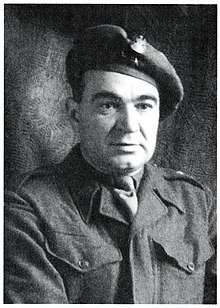 | |
| Born |
27 August 1904 Łódź, Poland |
| Died |
13 June 2002 (aged 97) Brandon, Florida State, United States |
| Allegiance |
|
| Service/ |
|
| Years of service | 1924–1925, 1939–1947 |
| Rank | Chief of the Intelligence Subdivision of 5th Kresowa Infantry Division |
| Unit | 10th Infantry Division, 5th Kresowa Infantry Division |
| Battles/wars |
Second World War Italian Campaign (World War II) |
| Awards |
|
| Other work | financial adviser in hospital, (Florida) |
Stefan Orzechowski (27 August 1904 – 13 June 2002) was a Polish military officer, a lieutenant colonel of the Polish Armed Forces. He was a diarist of 5th Kresowa Infantry Division.[1].
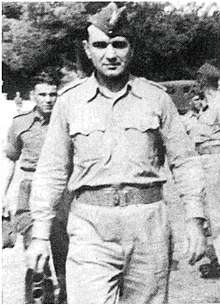
.
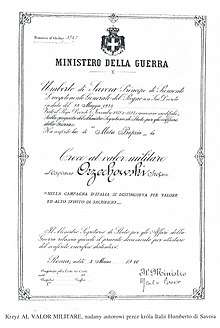
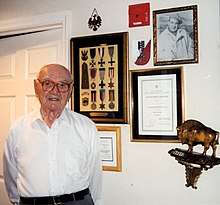
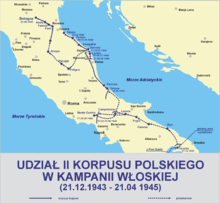
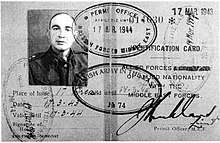
_-_visit_to_15th_Batalion_of_Polish_Armed_Forces%2C_Modena%2C_Italy%2C_1946.jpeg)
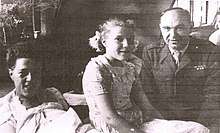
Youth
Stefan Orzechowski was born in 27 August 1904, in Łódź, Poland, then a part of Russian Empire (as a result of 19th century Partitions of Poland). His parents were: Julianna Orzechowska born Jankowska and Stanisław Orzechowski textile technician (Łódź was then one of leading European textile industry centres).
His education concerned the business activities. In 1923 he has completed commercial secondary school in Łódź. He was there an active member of scouting movement, as a Scout Leader in Polish Scouting and Guiding Association. During his school education he played football in scout's football team.
In 1924 Orzechowski has been called up to military service. Shortly he completed Officer Cadet School in Skierniewice and in 1925 he acquired podporuchik (second lieutenant) military rank.
In 1926 Orzechowski started working in Taxation Board in Łódź and simultaneously he undertook his studies on Political sciences Faculty of Warsaw Free Polish University (Outside Branch in Łódź). Next place of his work was "Elektrobudowa S.A." – Company acting in electro-technical industry – producer of transformers and electric motors. He ran there cost registering and then – in 1935 – he became sales department manager.
Beginnings of the service
During 1939 Invasion of Poland Orzechowski served in 10th Infantry Division – 4th Rifle Battalion, wchich has been broken and withdrawn to Modlin vicinity, and next – to the surrounding of Brest on Bug River (then territory of Poland). There was a plan to engage the 4 Rifle Battalion (together with other military units) in organizing a new defence line along Vistula and San rivers. However it can't be realized because of Soviet invasion of Poland on 17 September 1939 as a result of Molotov-Ribbentrop Pact (of 23 August 1939) and the order of Supreme Commander of non-resistance against Soviet Red Army.
Imprisonment in Soviet forced labor camp
In the night of 17–18 September 1939 Orzechowski has been taken prisoner. He then concealed his military officer rank. Otherwise he would be a victim of Katyn massacre (April – May 1940). Two-years period of 1940 – 1941 he spent in labour camp – first near Bolshoi Zaporizhia (Dnipropetrovsk Oblast). Next – as result of his refusal of working during Christmas Holidays – he was transferred to the so called "correction" labor camp in the far northern territory on Dwina River. It was downward of Kotlas town near the coast of White Sea (Komi Autonomous Soviet Socialist Republic – now Arkhangelsk Oblast). He began working there in mid-January 1940. There were extremely hard labour conditions (the mortality rate in the first year was 20%, and in the second – 25%). In such circumstances Orzechowski survived to the August 1941, when – after the Operation Barbarossa and Sikorski–Mayski agreement there was introduced so called Amnesty for Polish citizens in the Soviet Union. It enabled the recruitment of Poles imprisoned in Soviet forced labor camp system (Gulag) – to the new formed Anders' Army.[2]
Release of the camp
After the release of the camp and disclosure of his officer rank[3], Orzechowski has announced his presence – with a group of 1200 Polish soldiers – to 5th Wilenska Infantry Division in Tatischevo in Saratov Oblast, Russia. It was 6 September 1941. Then in spring 1942, he took part in exercises and training of Polish military units in Jalal-Abad in south-western Kyrgyzstan.
Evacuation from the Soviet Union to the Near East and transfer to Italy
In 1942 (between March and September) – Polish military units have been evacuated from the Soviet Union to Iran and next to Iraq. Orzechowski has been appointed there the intelligence officer in the Command of 5th Wilenska Infantry Brigade and – after the 15-month training in 1943 – he has been enlisted to the Command of 5th Kresowa Infantry Division as a part of II Corps. The II Corps has been shortly (in October and November 1943) transferred to Palestine, and then took part in the vast manoeuvres at Palestine and Lebanon territories. At the end of 1943 and in January 1944 the II Corps has been moved to Egypt and finally – in February 1944 – transferred by sea from Port Said to Taranto (Italy). Orzechowski continued service there, in the next years, till its demobilization in Britain in 1947, but February 1944 was the beginning of his involvement in the operations of 5th Kresowa Infantry Division – as a part of II Corps – in Italian Campaign, which lasted till April 1945.[4]
Participation in the Italian Campaign
His participation in the Italian Campaign may be divided into the following stages:
- from middle of February to 22 March – patrol and artillery struggles at Monte San Pietro and Monte Santa Croce regions,
- 11–18 May 1944 – Orzechowski share as an intelligence officer of the 5th Kresowa Infantry Division in Battle of Monte Cassino,
- 23 June – 31 August 1944 – Orzechowski share in activities alongside the Adriatic Sea coast – particularly:
- 14–18 July 1944 – struggles for Ancona,
- 20 July – 5 August 1944 – fighting at Ripe, Marche region,
- 6–10 August 1944 – fighting of Monterado and Cesano,
- 18–22 August 1944 – fighting of Metauro river,
- 23–31 August 1944 – attack on Gothic Line fortifications,
- Autumn 1944 – battle of Santa Sofia, fighting in Emilia–Romagna Emilian Apennines region, battles of Monte Grosso and Predappio and mountain battles in Predappio region,
- late autumn 1944 (November) – mountain fightings at Monte Testo, Monte Casaluda, Monte Agostino, battles near Monte Cerrero and Monte Fortino,
- December 1944 and the beginning 1945 – positional warfare, east of Senio river – among others at Riolo dei Bagni, Cuffiano, Monte dall Olio regions,
- March 1945 – completion of fighting strength (personnel, war material), and positional warfare alogside the Senio river,
- 9–21 April 1945 – battle of Bologna, breaking defence line along the Senio river, fighting alongside Santerno river,
- 21 April 1945 – conquest of Bologna and the end of fighting – according to the order of Command II Corps.[5]
Thus the beginning of Orzechowski "Battle Road Trail" in Italy – was landing of 5th Kresowa Infantry Division in Taranto (February 1944), and its conclusion – conquest of Bologna (April 1945). Nevertheless it wasn't end of Orzechowski service. Next – beginning from May 1945 – he has been appointed to social service, i.e. – a care for soldiers families and Polish refugees released from German internment camps, which lasted till autumn 1946. Then – i.e. at late autumn 1946 II Corps has been transferred to Britain and Orzechowski has been moved there with his family. He formerly had successfully rescued from Poland – his wife Mirosława Orzechowska (born Kowalska), daughter Jadwiga, and son Janusz.[6]
Aftermath
After the demobilization in 1947 – considering the difficulties in finding a job in his profession (finances, accountancy) in Britain Orzechowski has performed an electromechanical training and next emigrated with his family to Argentina. He has spent there 20 years till 1967, and afterwards he has moved to the United States. He has been engaged in Florida state as an financial adviser at the hospital.[7]
In 2001 Orzechowski has advanced to the rank lieutenant colonel[8]. He has been decorated for his military service with (among other): The War Order of Virtuti Militari (Silver Cross)[9], Cross of Valour (Poland)[10], Cross of Battle Deed of Valour of Polish Armed Forces in the West[11], and Italian War Cross for Military Valor[12].
Orzechowski was married (1929) to Mirosława Orzechowska (born Kowalska). They had 2 children Jadwiga and Janusz who took part in 1944 (aged 14) in Warsaw uprising. Orzechowski died in 2002 in Brandon, Florida. He left orphaned daughter physician – Jadwiga (married Ancaya) and grandchildren.[13]
References
- ↑ Stefan Orzechowski: [in Polish] Historia walk 5 Kresowej Dywizji Piechoty (History of fights of 5th Kresowa Infantry Division), Warsaw 1998, ed. by Oficyna Wydawnicza Volumen – Dom Wydawniczy Bellona, (Bellona Publ.)
- ↑ Stefan Orzechowski: [in Polish] Historia walk 5 Kresowej Dywizji Piechoty (History of fights of 5th Kresowa Infantry Division), Warsaw 1998, ed. by Oficyna Wydawnicza Volumen – Dom Wydawniczy Bellona, (Bellona Publ.), pp.16–19.
- ↑ It's worth to quote here, how Orzechowski has described in his book the introduction of so called Amnesty for Polish citizens in the Soviet Union, and disclosure officers's ranks by freshly released Polish former prisoners. He wrote there: "Most curious was general Zhukov call addressed to officers to step out the line at saluting base and his assurance of inviolability. Nobody has stepped out. After a few minutes of counsel with Zhukov – Anders and Sulik spoke to us. Both of them declared, that we are necessary and not be responsible for conceal of our military officers ranks. >Step out, please<. After such declaration, 31 officers simultaneously have stepped out the line at saluting base, and myself among them. It was worth seeing at the moment lifeless faces of NKVD officers - expressing the astonishment and distrust." - see: Stefan Orzechowski: Historia walk ..., op.cit., pp.16–19.
- ↑ Stefan Orzechowski: Historia walk ..., op.cit., p.21.
- ↑ Stefan Orzechowski: Historia walk ..., op.cit., pp. 33–182.
- ↑ See: [in Polish] Eduvigia Ancaya: Wrażenia z poróży na Kresy, "Nasz Czas", 2005, No 3, (653), 10–23 lutego (10–23 Feb 2005), pp.6–7.
- ↑ Stefan Orzechowski: Historia walk ..., op.cit., p. 194-197.
- ↑ (in Polish) Decyzja Ministra Obrony Rzeczpospolitej Polskiej z dnia 9 marca 2001 (Decision of Minister of National Defence of 9 March 2001)- See: https://commons.wikimedia.org/wiki/File:Copy_of_Stefan_Orzechowski_Lieutenant-Colonel_Nomination,_2001.jpeg
- ↑ See: The Register of Persons Awarded by Virtuti Militari Cross – http://www.stankiewicze.com/vm/vm_o.htm [access: 9 May 2018]
- ↑ See: https://pl.wikipedia.org/w/index.php?title=Kategoria%3AOdznaczeni_Krzy%C5%BCem_Walecznych&from=O
- ↑ See: https://commons.wikimedia.org/wiki/File:Copy_of_Stefan_Orzechowski_Diploma_of_Fighting_Feat_Cross_of_Polish_Armed_Forces_in_the_West,_1999.jpeg
- ↑ See: https://en.wikipedia.org/wiki/File:Stefan_Orzechowski_Diploma_of_Italian_Medal_of_Military_Valour,_1946.jpeg
- ↑ See: [in Polish] Eduvigia Ancaya: Wrażenia z poróży na Kresy, "Nasz Czas", 2005, No 3, op.cit., pp.6–7.
Further reading
- Wladyslaw Anders: An Army in Exile, MacMillan & Co. Ltd, 1949;
- [in Polish] Witold Biegański: Polskie Siły Zbrojne na Zachodzie, Warsaw 1990, ed. Krajowa Agencja Wydawnicza, ISBN 83-03-02923-1;
- [in Polish] 5 Dywizja Piechoty w dziejach oręża polskiego, Pruszków 1997, ed. Oficyna Wydawnicza "Ajaks", ISBN 83-87103-20-9;
- [in Polish] Stefan Orzechowski: Historia walk 5 Kresowej Dywizji Piechoty (History of fights of 5th Kresowa Infantry Division), Warsaw 1998, ed. by Oficyna Wydawnicza Volumen – Dom Wydawniczy Bellona, (Bellona Publ.);
- [in Polish] Melchior Wańkowicz: Bitwa o Monte Cassino, v. I-III, 1st publ. Rome-Milano, 1945–1947, ed. by: "Wydawnictwo Kultury i Prasy II Polskiego Korpusu" (II Corps Culture&Press Publishers) and later: Warsaw, 1978+ (PAX Association Publishers and many other in the next years).